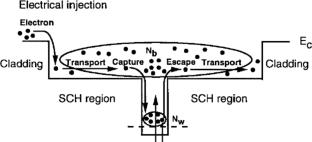Influence of carrier transport on modulation characteristics of quantum-well semiconductor lasers
Abstract
We discuss modeling the influence of carrier transport phenomena in quantum well (QW) semiconductor lasers on the device's current modulation characteristics. The escape and capture of charge carriers between the QW and the separate confinement heterostructure (SCH) are considered the major carrier transport phenomena. The small-signal analysis is applied to linearize the QW laser's rate equations and obtain expressions for the intensity modulation (IM) response. The carrier transport is assessed in terms of the lifetimes of the carrier escape and capture processes. In this study, we evaluated the impacts of these transport times on both the modulation bandwidth and response peak frequency. In addition, we used the obtained results to assess the tolerance of using the simple standard two-rate equation (STREs) model to describe the modulation properties of QW lasers. We demonstrate that when the capture lifetime is less than 20 ps and the escape lifetime is greater than 0.1 ps, the modulation bandwidth and response peak frequency reach their maximum values, which interestingly match the results simulated by the STRE model. With departures from the ideal ranges of these transport lifetimes, the tolerance of applying STREs becomes poorer. The findings in this study advance and supplement the theory and simulation of QW laser diodes.


 求助内容:
求助内容: 应助结果提醒方式:
应助结果提醒方式:


